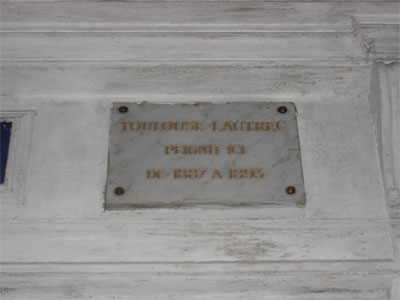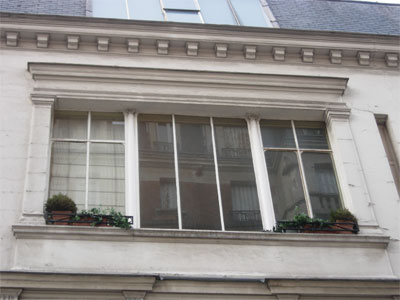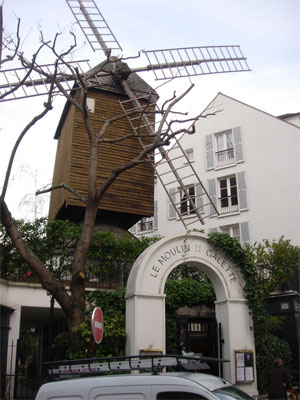
 |
 |
 |
 |
 |
 |
 |
|
Sur les traces d'Henri de Toulouse-Lautrec
I chose to follow in the footsteps of the painter/artist Henri de Toulouse-Lautrec because some of his images have become synonymous with the flamboyant Paris of the end of the 19th century.
Like many artists past and present, Toulouse-Lautrec lived and worked in Montmartre. He lived the nightlife of the cabarets and bars such as the Moulin Rouge and then documented the dancers and guests in his artwork.
I visited several of his homes, studios, and favorite places in Montmartre. I would have liked to have visited the Musée de Montmartre as well, but it was closed the day I went, and I didn't have time later in the week. I did get to see some of Toulouse-Lautrec's original artwork in person at Musée d'Orsay.
No 19 Rue Fontaine: This is one of the first places he lived in Paris. Apparently, the ground floor was also at one time Degas's studio, although there is no plaque or sign marking it as such. There is, however, a little plaque above the door that says, "Toulouse-Lautrec peignit ici de 1887 - 1893".

No 20 Rue Fontaine and no 21 Rue Fontaine: I took at look at these addresses as well because Lautrec also lived here at one time after moving to Paris in 1881. Here it is impossible to know which floor Lautrec lived on, so I just used my imagination to imagine which window, Lautrec might have looked out of.
Moulin Rouge: It was not open when I came by on a Tuesday morning, but inside by the bar, they still have original posters painted by Lautrec. (http://www. moulinrouge.fr)
104 Blvd de Clichy: After poking my head in the Moulin Rouge, I almost passed by this address. I had read that one could see through the gates here to a studio where Lautrec studied along with Van Gogh. I didn't have any luck here... I couldn't see a lot or gain access to the inside.
No 7 Rue Toulaque: The large windows on the top floor were Lautrec's studio. Apparently, he also held regular orgies here as well. It looks like an absolutely fabulous space. I can imagine the view Lautrec had down a great big hill on his left everyday when he left his studio.

Moulin de la Galette: Now a really cool windmill, at one time, this was apparently a happening place, known for it's risquée can-can dancers

La Bonne Franquette: Phew! It was quite a climb to get all the way up here. Lautrec had disfigured and un-naturally short legs thanks to the combination of a childhood accident and a genetic disorder. It really made me wonder how the hell he managed to climb up here everyday. In Lautrec's day, La Bonne Franquette was a bar where Lautrec and other artists (including Van Gogh) drank lots of absinthe. Now, it is in a sort of touristy area, where lots of souvenirs and posters (some featuring Lautrec's works) can be purchased. I also read that is was at La Bonne Franquette that Lautrec invented and drank "the earthquake" which is a concoction of absinthe and cognac. After this, I am surprised he could make it down the hill again. (http://www.labonnefranquette.com)

Jean-Paul Gaultier's house: This is the last address Lautrec lived in before he died away from Paris. Again, I couldn't really see past the gates here or get inside. I have since learned that Jean-Paul Gaultier, Paris fashion designer lives there now... so this sort of makes sense.
— Alice
Related links:
Montmartre
Musée d'Orsay
le 16 janvier
Sur les traces d'Honoré de Balzac
Sur les traces d'Alexandre Dumas
Sur les traces du Marquis de Sade








